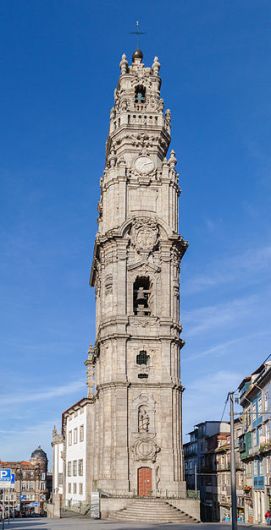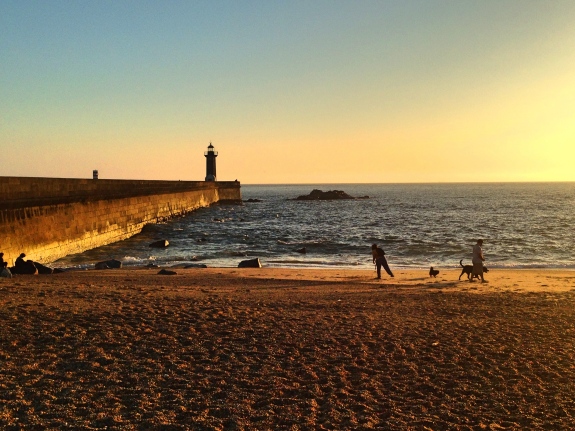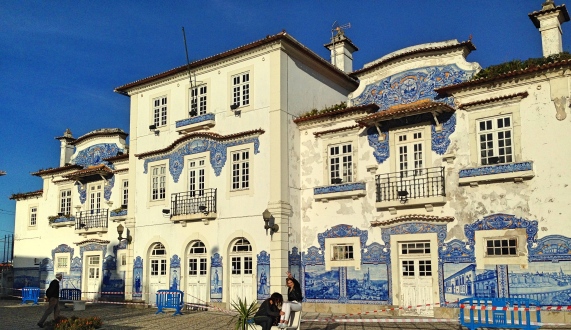The train from Vigo left the station, traveled around the bay’s edge, and then turned south on its voyage to Oporto. I was vainly trying to read Hegel. Through the window I could see the Galician landscape, green and woody; then the tracks took us along the ocean shore, showing us the waves lapping the sand. It was not a high speed train and so the relatively short voyage took three hours.
The border between Portugal and Spain is almost imperceptible. In the north it follows the path of the River Miño, a relatively small waterway that could never have been a serious impediment to travel. In the south, there isn’t even a river. It makes me wonder how such a notable contrast in culture and language arose in the first place.
Immediately across the border is the Portuguese town of Valença, which is known for its baroque fortress overlooking the river, bulwarked by polygonal walls and trenches. Further on we passed by the town of Barcelos, which has a well-preserved medieval center and bridge. Finally the train creaked to a halt in its final destination:
Oporto
With around 300,000 inhabitants, Oporto is the second-largest city in Portugal and the urban center of the country’s northern half. Its real name in Portuguese is Porto. “O” is the Portuguese word for “the,” and “porto” means “port,” so that the name “Oporto” is just “the port” mistakenly transcribed. In any case, the name is appropriate, considering the city’s maritime orientation. Situated along the banks of the River Douro, the fishing and shipping industry have been important to the city since Roman times.

The most beautiful views of the city are to be found along this river, as the banks slope steeply down to the water, and the city follows like tumbling dice. Across this divide the two halves of the city are connected with a series of towering bridges. Among the newer bridges is the Arrábida Bridge, which had the biggest concrete arch in the world when it opened in 1963 (I don’t know what has surpassed it); and there is the sleekly modern São João railroad bridge, which eschews the arch for a wavy line suspended on two pillars.
But the most beautiful bridge in Oporto is the Ponte Dom Luis I. This bridge is sometimes confused with the nearby Maria Pia Bridge—a railroad bridge designed by Gustave Eiffel—and for good reason, since the two look very similar. This is not accidental, of course, since the Ponte Dom Luis I was designed by the engineer Théophile Seyrig, one of Eiffel’s disciples. The main difference between Seyrig’s bridge and Eiffel’s is the former’s lower deck; and this feature is extremely convenient, since it means that pedestrians and drivers near the river don’t have to ascend the banks to use the bridge. This was the second innovative bridge I have seen by one of Eiffel’s disciples, the first being the Vizcaya Bridge near Bilbao. Both of these, as well as Eiffel’s own bridge, are models of elegant design, combining function and style.

At the time the bridge was completed, it was the largest of its type in the world; and still today it is an impressive structure, standing 85 meters (279 feet) tall. Nowadays cars (and people) can cross the Ponte Dom Luis I on the lower deck, while the upper deck is reserved for pedestrians and the tram. The top of the bridge offers, without a doubt, the best view of the city, showing the antique city center crowded along the riverbanks, their orange roofs glowing in the sunlight, while ships cruise by in the sparkling water below. On one side of the river, a medieval wall still clings to hillside; and beyond one can see the tower of Oporto’s cathedral, and the still more impressive Clérigos Tower in the distance. The courtyard of Serra do Pilar monastery presides over the bridge’s other end, creating a satisfying symmetry.


Oporto has much to offer in the way of churches. The city’s cathedral is a sparse but elegant Romanesque structure, with a narrow nave supported by a barrel vault. Not far from here is the Church of Santo Ildefonso, with a façade of the blue tiles that are such a pleasing aspect of Portuguese architecture. The aforementioned Clérigos Church sits on a narrow block; and though its ornate Baroque decoration is impressive, it is hard to pay attention to anything but its massive bell tower on its back end, so tall as to be visible from many points of the city. But any list of churches is bound to come up short; every time I walked to a new part of town, I was surprised to find stately and grand church buildings.
One church does stick out in my memory, however, and that is the Church of São Francisco. From the outside it does not look like much: a sliver of gothic windows can be seen from the back, while the entrances of the building complex are all crowded around a little square. Nevertheless, this modest structure is the best-preserved gothic building in the city, which is one of the reasons it was designated as UNESCO World Heritage.
The church’s somewhat unassuming exterior gives way to a detonation of art once the pilgrim passes through the door. Here Baroque is triumphant, covering every surface with intricate designs and elaborate sculptures, flowering forth like spring trees. Every altar showcases a cacophony of forms, overwhelming the viewer with fine details; my favorite is the magnificent altar showing the Tree of Jesse, the family tree extending from the father of King David down to the Virgin. I can understand why some may be put off by the richness of the decoration; but I am always impressed by such excess. The eye struggles in vain to take it all in; and finally I turn away, defeated.

Another unforgettable section of the church are its crypts. Wealthy patrons of the Franciscan Order (to whom this church belonged) chose to be buried here, in catacombs accessible through an adjacent building. It is an eerie space, shadowy and cold, illuminated by fiery yellow lights. Most hair-raising are the piles of human bones visible through openings in the floor. These are the common graves of the Franciscan brothers, I believe, accumulated over hundreds of years.
The Church of São Francisco was originally part of a convent, complete with an adjoining cloisters; but during Portugal’s Liberal Wars (1828-34), a fire destroyed most of the convent. This unfortunate destruction at least allowed space for the city’s Commercial Association to build their lovely Palácio da Bolsa, or Stock Exchange Palace, in its place.
The neoclassical building that now stands is a veritable church of finance. To visit one must join a guided tour, which is no bad thing; my guide did an excellent job explaining the history and art of the structure. We began in the Patio das Nações, or the Courtyard of Nations, so-called because of the paintings of the coats-of-arms of various countries with which Portugal does business. On one wall I even spotted the eagle of the United States. As in a real palace, every room, even the stairwell, is lavishly decorated; yet unlike a palace, the iconography is calculated to glorify commercial exploits. Here we can see, manifested in stucco and stone, the wealthy bourgeois usurping royalty as the dominant force in the country.
I particularly remember the Sala das Assembleias, the merchant equivalent of the throne room, all of it decorated in fake lacquered wood (actually the “wood” is painted on) and filled with elegant furniture. Yet the most marvelous room in the building is without doubt the Arab Room, an enormous space whose walls are decorated in a Neo-Mudéjar style, imitating the stucco patterns of the Alhambra, yet adding ostentatious colors to the mix. If the Commercial Association wanted to impress visitors with their splendor, they did an excellent job.

If you have even a passing taste for wine, it is criminal to visit Oporto without going to at least one winery. The city is, of course, the home and namesake of Port wine; and there are several well-known wineries located across the river. In case you are not familiar with Port, this is a dark, red, and sweet fortified wine—about 20% alcohol by volume—that is normally drunk with dessert.
This wine has historically been very popular in England, largely thanks to the Methuen Treaty of 1703, which lowered import tariffs on Portuguese products while war with France made French vintages an impossibility across the channel. For this reason, too, some of the most prominent Port companies are owned by British families, such as the one I visited, Taylor’s. The visit consisted of a self-guided tour, with a tasting at the end. What most sticks out in my memory were the photographs of the terraced banks of the River Douro, the mighty river whose misty climate provides the home for the grapes.

The most famous dish of Oporto is the francesihna, which must be seen to be believed. Though its name means “little Frenchie” in Portuguese, it is neither little nor French. It is a double-decker sandwich, whose bread struggles to contain ham, sausages, and roast pork. Smothered with melted cheese, and perhaps a fried egg for good measure, the sandwich is then bathed in a tomato-beer sauce and placed in a bed of French fries, where it awaits its fate. By happenstance I stumbled upon a small restaurant called Bufeta Fase, which has great reviews and correspondingly great francesihnas. When I went the place was full of Portuguese people, which is a good sign.

My belly full of port and francesihna, I felt that I had better take a long walk. I decided that I would try to go all the way from the city center to the ocean port, following the course of the river. This course led me through the most attractive neighborhood in the city, the Ribeira, full of colorful houses arranged in a jumble along the river. On the other side of the river you can see some of the old boats that were used to transport the wine in the days before technology made our lives easier and less romantic. Nowadays the main cargo transported on the River Douro are tourists on ferries.
The walk to the port is long and passes through some nondescript areas, until gradually the city simmers down into town, and the ocean begins to take shape before you. Eventually I was walking past small houses and docks full of personal fishing boats. The other side of the port is dominated by an attractive sandy bay, now a natural park. I arrived at the Carneiro beach just as the sun was dipping below the horizon, lighting up the ocean a fiery red. I walked to the lighthouse, which sits on a boardwalk that extends like a concrete arm into the water, and then turned wearily back home. Now I had to do it all in reverse.

This concluded my time in Oporto. As an afterthought, I would also like to include a note on the Portuguese language. Etymologically and grammatically, it is the closest Romance language to Spanish. For this reason any Spaniard can read basic Portuguese with little trouble. But spoken Portuguese—at least in Portugal—could hardly be more distinct. Indeed, to an untrained ear it hardly sounds like a Romance language at all, but rather Slavic, not only in its consonants and vowels, but even its spoken rhythm.
Apparently one reason for this perceived difference is because the Portuguese spoken in Portugal (as opposed to that spoken in Brazil) is stress-timed, which means that unstressed syllables are deemphasized to preserve a fairly constant gap between stressed syllables; whereas Spanish is a syllable-timed language, so every syllable, stressed or unstressed, takes up roughly the same amount of time. English is a stress-timed language, too, which perhaps helps to explain why Portuguese people are notably better than the Spanish at speaking English. I have had no trouble getting by in Portugal using English; even in small shops outside the city center people have spoken remarkably well. I have also been told that, unlike the Spanish, who often dub movies and shows, the Portuguese watch everything with the original audio—which would help explain the performance gap.
I also must note that, as soon as the you get out of the tourist center, you can still see signs of Portugal’s economic crisis. Buildings are in poor repair or entirely in ruins, and the streets are seldom buzzing with life. The recovery has been slow indeed. And when you see that, behind the numbers and charts, there are ordinary people who have suffered from the downturn, you can get a sense of the anger and despair that the institutional status quo can engender.
Aveiro
Having some extra time in Oporto I decided that I would venture out and explore a smaller town. This led me to Oporto’s central train station, São Bento, which is itself worth visiting for the tile-work in the main lobby depicting scenes from Portuguese history. My destination was Aveiro, recommended to me by a Spanish teacher.

The city of Aveiro is largely famous for its canals, which is why it has been nicknamed the “Venice of Portugal.” These waterways are a pretty sight, with colorful gondolas cruising by, each of them filled with tourists covered in baseball caps and sunglasses, snapping photo after photo. Even without the canals, the town would be attractive for its many colorful tiled building—a style called “azulejo,” which combined form and function, since the tiles decorate while helping to keep the building cool.

With a busy and beautiful port, and a thriving tourist industry, Aveiro is one of the most affluent areas in the country. The economy is quite diversified, as many locals work in salt extraction plants; and the city also contains one of Portugal’s more important universities. In many ways the city is an oasis.
Nevertheless I managed to get into a sour mood shortly after I arrived. Though I love to travel, the sight of shops selling tourist knickknacks, the sound of American families bickering as they walk by, the overpriced and inauthentic restaurants with gaudy décor, the attractions that entertain but do not instruct—in short, travel conceived of alternately as a resort or as an amusement park—makes me feel bitter and out of place. Unless I am learning something, then it is hard for me to justify going to another country; if I want fun, I might as well stay at home and have a beer.
I cannot say that this sour mood is either fair or rational; nor is it pleasant. To escape from the crowds and clear my head, I walked out towards the port. This has been divided with a series of narrow land-bridges, making the area into a kind of marsh, with pockets of water divided like fields of wheat. Frankly I don’t know the purpose of this arrangement; but the result is fascinating and beautiful.
I kept walking and walking, until I lost myself in the labyrinths of land and water. There were little buildings out in these marshes, and a few old boats floating in the water; yet nobody seemed to be around. Soon I was so far out that I could forget about Aveiro. A peaceful silence hung in the atmosphere. The air was clear, except for swarms of tiny, harmless gnats that buzzed in circles to no apparent purpose. As I rounded a bend I was surprised to find a flock of flamingos lounging in the water. They were no less surprised to find me, and soon took off, flapping their enormous wings with impressive alacrity, disappearing from sight in a matter of seconds. They are magnificent beasts.

The further out I went, the more elated I felt, savoring the joy of being alone with nature. Yet my joy turned to anxiety as I began to worry that I couldn’t find my way back. A few wrong turns led me to dead ends, where the land bridges terminated in water, forcing me to retrace my steps through the tall grass. A couple times I missed my footing and almost slipped into the water. I imagined what the news would say if I drowned in the marshes of Aveiro: “Dumb American Tourist Gets Lost in Portuguese Bay.”
After three or four moments of fear, despair, and self-reproach, I successfully retraced my own steps and found my way back to solid land. Refreshed, rejuvenated, and greatly relieved, I walked back to the train station to get back to Oporto. Do not let my sour mood dissuade you. Aveiro is a beautiful place, both the town itself and the surrounding area.
This was my final day of Holy Week vacation. The next day I flew back to Madrid, and to work, feeling more at peace than I have ever felt before or since.
What a wonderfu post.
LikeLiked by 1 person
Thanks very much!
LikeLike